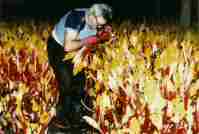Early history
Rhubarb is a native plant of Mongolia and is believed to have arrived in Italy in the 15th or 16th century. Large quantities were taken to China on the Silk Road, and it has been recorded that this road could have been known as the Rhubarb Road! A Yorkshireman, Sir Matthew Lister, introduced edible garden rhubarb into England from Italy around 1620. At first it was appreciated for its medicinal qualities, but from the 1780’s the chopped stalks began to be used as a substitute for gooseberries in pies. In the late 1870’s, Joseph Whitwell erected forcing sheds, where it was grown in the dark, and after that the expansion of the rhubarb industry was very rapid.
The Rhubarb Triangle
The soil in this area was of a type that suited the species. Cheap coal from the local coal mines was available to heat the forcing sheds as were large quantities of horse manure and ‘night soil’ from the urban areas. This resulted in the area of land between Leeds, Wakefield and Morley becoming known as the Rhubarb Triangle and over 95% of the forced rhubarb grown in England came from this district. Around 1900, the area was famous throughout Europe for the quality of its early rhubarb, which reached London markets in time for Christmas when it commanded a very high price. Large quantities were also purchased by agents for the French market in Paris. Most of the growing and forcing was done by many hundreds of small family farmers. It was only in later years that some growers expanded and owned many thousands of roots and extensive forcing sheds.
The Rhubarb Special
Around the 1870’s, the railway companies were transporting large amounts of rhubarb, especially to the London Covent Garden and Spitalfields Markets, and began to run a train with express status to carry nothing but rhubarb. The train was run by the Great Northern Railway Company and left Ardsley station every weekday night during the forced rhubarb season from just before Christmas until Easter. It ran every year until the 1961-2 winter when a rail strike caused the growers to seek alternative means of transport to get the very perishable commodity to their markets.
From that time, road transport began to take over, being more flexible as the pattern of marketing had changed and London no longer had the monopoly of the trade. At its peak, the Rhubarb Special was taking over 200 tons of rhubarb every day from Yorkshire to London.
A period of growth
From the 1900’s to 1939, the rhubarb industry continued to expand, covering an area of about 30 square miles (20,000 acres). The long, low, felt-covered sheds were a common feature of this area, as were the railway wagons which went round the farms collecting the recycled wooden orange-boxes of rhubarb each afternoon. Cardboard boxes came in later years.
Effects of WWII
Fuel shortages and rationing during the 1939-45 war brought changes to this unique local industry, as it became difficult to heat the sheds. Cinders from the dustbins collected by the Refuse Department were used to overcome the fuel shortage, and after the war oil fired boilers became the norm. In this period, forced rhubarb was regarded as a luxury and didn’t figure very highly in the Government’s plans, but even so its price was controlled at the equivalent of 4.5p per lb wholesale and 5p per lb retail. A ‘Black Market’ in rhubarb developed with extra payments being made over and above the controlled price throughout the war.
Green-top jam
Rhubarb was allowed to grow for 2 to 3 years and not harvested, so that the roots could gain strength before being taken into the forcing sheds. An official of the Government Food Office, which was responsible for feeding the nation, saw all the rhubarb being allowed to die back and rot in the fields as a waste of potential food, having no knowledge of the rhubarb industry. So orders were given that this green-top rhubarb had to be harvested and was sent to a local jam factory where it was made into pulp, enhanced with a variety of different flavours and made into various ‘seedless’ jams. This policy continued throughout the War years, but the rhubarb roots that had been pulled as green-top could not be forced, and this resulted in a reduction in the amount of forced rhubarb that could be produced in winter.
Decline of the industry
Reduction also resulted from the greater variety of fruits available from abroad as people’s tastes altered and prices of the new fruits fell. In the late 1960’s and early 1970’s, many small fields which had been used to grow rhubarb were sold for building houses, as they were very close to urban areas. Statistics show that in 1966 there were 1022 acres of rhubarb in this district, but by 1980 this had fallen to 422 acres, and since then it has fallen even further. In the Rhubarb Triangle there are now only around 10 growers of this unique vegetable which is served as a dessert.




You must be logged in to post a comment.